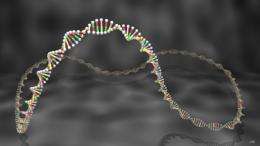DNA patterns of microbes

(PhysOrg.com) -- The genomes or DNA of microbes contain defined DNA patterns called genome signatures. Such signatures may be used to establish relationships and to search for DNA from viruses or other organisms in the microbes' genomes. Foreign DNA in bacteria has often been associated with disease-causing abilities.
In his doctorate, Jon Bohlin studied methods for examining the genome signatures of microbes. Since foreign DNA in the genomes of bacteria often give the bacteria disease-causing abilities, part of his work was aimed at developing fast and simple methods for finding foreign DNA.
The explosive development in technology for sequencing DNA molecules has made enormous amounts of genetic information available for analysis. This has both led to an upheaval in biological research and simultaneously created a great need for fast and effective methods of interpreting the steadily increasing amounts of information.
To solve the challenges that these large amounts of information present, bioinformational research is utilising techniques taken from statistical, mathematical and information technologies. Most of the methods that were used in this project were originally established in the field of theoretical bioinformation. However, because of insufficient information, it was not previously possible to investigate the methods properly.
Bioinformational methods reveal a complex picture of the microbial genome
The increasing number of sequenced genomes that has become available during recent years has made it possible to test the methods' advantages and disadvantages, possibilities and limitations. This has given us more reliable information on how different microbes' DNA composition is influenced by environment and lifestyle.
The methods can also be used to deepen our understanding of the evolutionary development that follows natural selection at the DNA level. Such knowledge is absolutely necessary to understand mechanisms leading to bacteria becoming pathogenic (disease-producing) and resistant to antibiotics.
This doctorate comprises analyses of the genome signatures of microbes, and describes how genome signatures vary in the genomes of both closely-related microbes and among different microbial genomes. One of the central questions is how environment influences the genome signatures and if this influence may be may be linked to different characteristics of the microbes, such as size, DNA composition, lifestyle and niche.
Cand. scient. Jon Bohlin defended his Ph. D. thesis, entitled "Genomic signatures in prokaryotic genomes", at the Norwegian School of Veterinary Science, on June 5, 2009.
Source: Norwegian School of Veterinary Science (news : web)














